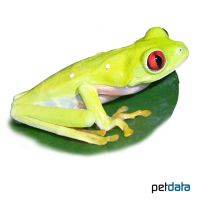Red-eyed Treefrog (Agalychnis callidryas)
| Red-eyed Treefrog Agalychnis callidryas | |
|---|---|
| Name | Red-eyed Treefrog |
| Name Lat. | Agalychnis callidryas |
| Family | Hylids |
| Family lat. | Hylidae |
| Order | Frogs & Toads |
| Order lat. | Anura |
| Origin | Central America |
| Habitat | Humid forest |
| Diet | Small live insects |
| Humidity | 70-100 % |
| Behavior | Peaceful, nocturnal |
| Keeping | Individual, pair, group |
| Care Level | Difficult |
| Breeding | Moderately difficult |
| Housing | Humid terrarium |
| Life Span | 10 years |
| Protection | CITES Appendix II; EU Annex B |
| Metric Units | |
| Size | 8 cm |
| Temperature | 22-28 °C |
| Housing Size | 40 x 40 x 60 cm |
| US Units | |
| Size | 3" |
| Temperature | 72-82 °F |
| Housing Size | 15" x 15" x 25" |
Distribution and habitat
The crepuscular and nocturnal, arboreal red-eyed treefrogs are native to the entire Central American region from Yucatán (Mexico) to the southern border of Panama. They live primarily in lowland rainforests near bodies of water, but also in the forested slopes of adjacent mountain ranges.
Maintenance
For 1-2 animals, the minimum area of the terrarium is 1,600 cm² with a minimum effective height (measured without substrate) of 50 cm. This corresponds to a base area of e.g. 40 x 40 cm. For each additional animal, an additional 500 cm² area and 3 cm height must be provided. The terrarium should be placed in a quiet place without sunlight.
You need a terrarium with a substrate of loose, absorbent, non-rotting substrate such as sand-peat mixture, coconut fibers or sphagnum moss with a drainage, plus pieces of bark, flat stones, strongly branched climbing branches, preferably entwined with climbing plants, a dense planting (e.g. Tradescantia, Ficus, Hoya, Bromeliads) and a shallow water basin. Potted plants that can be easily removed for cleaning are advantageous. At least twice a day, except during seasonal dry periods, the inside of the terrarium must be finely sprayed with water (humidity), but a rain or mist system is better
| Temp. day: 22-28 °C | Temp. night: min. 21 °C | Humidity: 70-100 |
The lighting duration must be 10-14 hours depending on the season. Daylight fluorescent tubes with low UV content are very suitable, supplemented with spotlights
During the seasonal dry period (3-5 months) the humidity is reduced to 50-80 %.
Diet
The food supply consists of live insects such as crickets, small grasshoppers and crickets, as well as mealybug larvae and cockroaches. After a period of habituation (feeding with tweezers), special ready-made food is often accepted as well. Food should be offered to adult animals 2-3 times per week, young animals must be fed daily. It is important to add minerals and vitamins regularly (e.g. by dusting the food animals).
A varied diet promotes health and prevents deficiency symptoms.
Reproduction and breeding
Males are smaller than females. During the mating season, the male may develop rutting calluses on the forelegs. The spawn is attached to the underside of a leaf in clumps of 50-70 eggs above a water surface after the rainy season. After only a week, developed larvae (tadpoles) drop out of the liquefied jelly into the water. The larvae initially filter microorganisms from the water and later eat animal and plant food. After about 50 days, the transformation (metamorphosis) is complete and the frog leaves the water.
Species protection
The animal population must be reported in writing to the competent authority immediately after the start of keeping. Subsequently, all arrivals and departures must be reported.
Protection of species: WA Annex II; EU Annex B. The proof of purchase is the required proof of origin for the animal. Please keep it in a safe place!
Important
They emit characteristic sounds (croaking) and are very adept at climbing with their finger and toe tips widened into adhesive discs. Their mucous membrane is very sensitive, accordingly, the necessary humidity and maximum cleanliness must be ensured.
Before purchase, a terrarium should be prepared that meets the species-specific needs. Necessary are good ventilation without drafts, as well as devices for measuring temperature and humidity. The lighting has to correspond to the species-specific day-night rhythm and should be placed in such a way that the animals cannot injure themselves. The terrarium should be locked in such a way that neither unauthorized persons can open it nor the animals can escape. Special attention must be paid to thorough hygiene and impurities must be removed regularly
Further literature can be found in your pet store
References
Text: petdata; Image: petdata
Source: ENGELMANN (2006): Zootierhaltung - Tiere in menschlicher Obhut: Reptilien und Amphibien, Harri Deutsch Verlag; VDA & DGHT (2006): Haltungsrichtlinien für die Haltung von Anuren; HANS-JOACHIM HERRMANN (2005): Terrarienatlas Bd. 2, Mergus Verlag
- Gemäß § 21 Abs. 5 Tierschutzgesetz idgF
